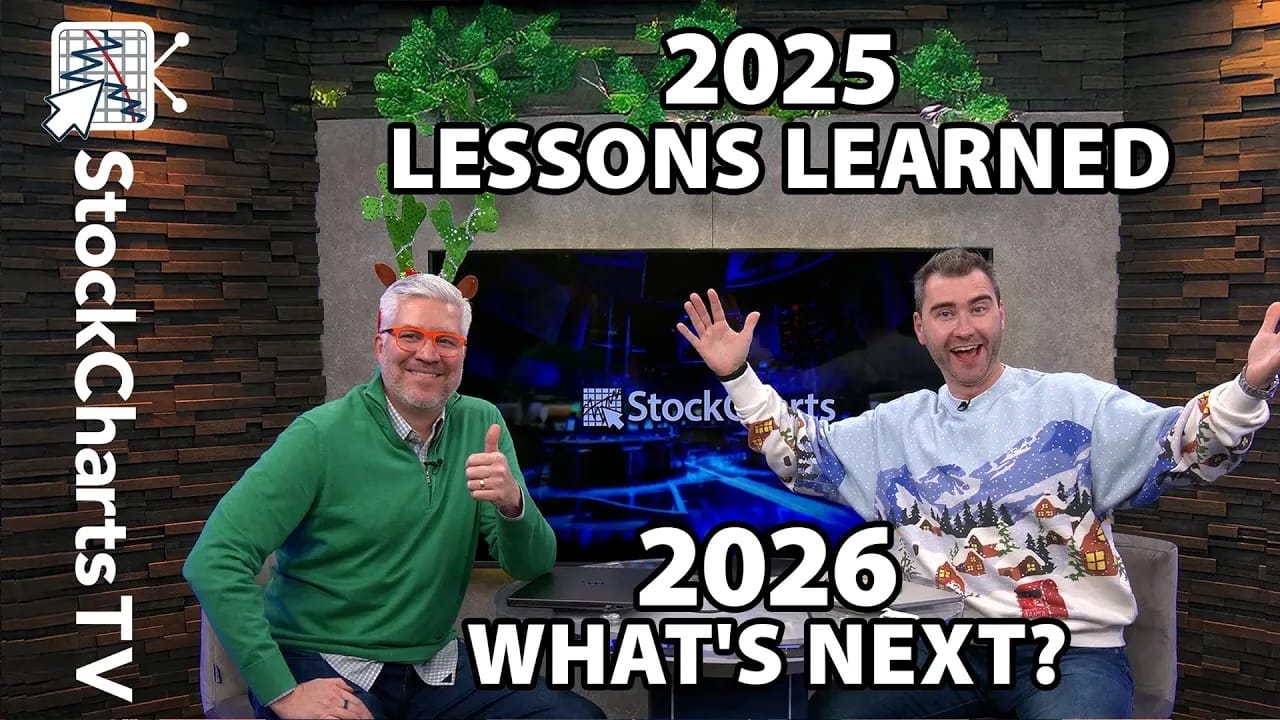WEBINAR DETAILS, LARGE-CAPS WEAKEN, SMALL-CAPS HANG TOUGHER, $NDX AND $SPX BREADTH BREAKS, SECTOR BREADTH LINES TURN MIXED, KEY EQUAL-WEIGHT SECTORS HOLD SUPPORT, SCANNING FOR YEAR-TO-DATE STRENGTH
WEBINAR RECORDING AND TIMELINE... The charts and commentary below come from the webinar recording. Note that not all webinar charts are included. Overall, the market remains boring on the outside and mixed up on the inside. The S&P 500 is flat for the year, but some key sectors and industry groups are not flat. Today's webinar will look at just how boring the broader market has become in 2015. I will then look under the hood to show some rotations at work and some breakdowns in key AD Lines. Despite weakening breadth, the key equal-weight sectors have yet to break support and turn bearish. I will then show some select ETF charts, run through at demo for year-to-date changes and then focus on some select stocks. Click here for today's webinar

(click to view a live version of this chart)
Chart 1
LARGE-CAPS ROLL OVER SHORT-TERM... Chart 2 shows the S&P 500 SPDR (SPY) leading the market lower over the last three weeks with a decline below 209. This is still a rather modest decline because the ETF is still less than 3% from an all time high. The green dotted lines mark a rising channel to define the advance since early March and mark support. The lower line and April-May lows combine to mark support in the 207-208 area. I am hesitant to call this a major support level because there is also a lot of support in the 204-205 area from the March lows.

(click to view a live version of this chart)
Chart 2

(click to view a live version of this chart)
Chart 3
Weakness within the S&P 500 is fairly broad because the Equal-Weight S&P 500 ETF (RSP) is also down over 2% from the May highs. Chart 3 shows RSP gapping down on May 26th, holding this gap and gapping down again on June 4th. Both gaps held and these are short-term bearish. Also notice that RSP broke the channel trend line. The negatives are piling up, but they are still short-term issues because RSP hit new highs in May and has yet to break support. Note that both SPY and RSP are short-term oversold and getting ripe for at least a bounce.
MID-CAPS AND SMALL-CAPS HANG TOUGHER... The S&P MidCap SPDR (MDY) is also down over the last few weeks, but down less than SPY and holding up better. Chart 4 shows MDY falling around 2.3% from the May high with a short-term trend over the last three weeks. Longer term, the lows from late March and early May mark key support in the 272 area. The indicator window shows the SCTR edging higher as MDY shows relative strength the last five weeks.

(click to view a live version of this chart)
Chart 4

(click to view a live version of this chart)
Chart 5
Chart 5 shows IJR with a rising wedge over the last five weeks. This rising wedge is potentially bearish because IJR has yet to exceed its April high and could form a lower high. In other words, the rising wedge could be a counter-trend bounce. For now, however, the wedge is rising, the immediate trend is up and IJR shows relative strength. The late May lows and wedge trend line mark support in the 116-117 area. A break below this zone would reverse the wedge, form a lower high and argue for a move towards the 113 area.
LARGE-CAP BREADTH WEAKENS... Chart 6 shows the AD Lines for the S&P 1500, S&P 500, S&P MidCap 400, S&P Small-Cap 600 and Nasdaq 100. First, note that the S&P 1500 AD Line ($SUPADP) has yet to break support and remains in an uptrend. Even though this broad market AD Line is fine, notice that the S&P 500 AD Line ($SPXADP) broke below its March lows and is the weakest of the group. The Nasdaq 100 AD Line ($NDXADP) formed a lower high and bearish divergence over the last few months. It has yet to break the March low, but is awfully close. These breadth indicators reflect selling pressure in large-caps and large-cap tech stocks.

(click to view a live version of this chart)
Chart 6
BREADTH WEAKENS FOR CONSUMER DISCRETIONARY AND TECH... Chart 7 shows the AD Lines for five big sectors that account for around 75% of the S&P 500 (source: www.spdrs.com). Two are bearish and three are still bullish. The Tech AD Line ($XLKADP) formed a lower high and broke support (bearish). The Consumer Discretionary AD Line ($XLYADP) formed a lower high from March to April and broke down in May. Breadth for these two key sectors is deteriorating and this is negative.

(click to view a live version of this chart)
Chart 7
Elsewhere, the Finance AD Line ($XLFADP) and Industrials AD Line ($XLIADP) are basically flat. Neither has yet to break support and turn bearish. The HealthCare AD Line ($XLVADP) is the strongest of the group because it hit a new high in late May and remains above its support zone.
UTILITIES AND MATERIALS AD LINES BREAK... Chart 8 shows the AD Lines for utilities, consumer staples, materials and energy. These four sectors account for around 25% of the S&P 500 and their AD Lines are bearish. Combined with the bearish AD Lines for technology and consumer discretionary, this means the majority of the AD Lines are in bear mode right now. Before getting too bearish, note that the actual sector ETFs have yet to break down and price matters more than breadth. Breadth is warning, but price has yet to confirm.
The Consumer Staples AD Line ($XLPADP) peaked in early March and formed lower highs in April and May. Notice the break down in late May. The Utilities AD Line ($XLUADP) edged higher from late March to late May, but broke down with a sharp decline in June.

(click to view a live version of this chart)
Chart 8
The Energy AD Line ($XLEADP) is the weakest of the group because it formed lower highs in February and April, and hit a new low this month. The Materials AD Line ($XLBADP) formed a lower high in mid May and broke down over the last two weeks.
SCANNING FOR YEAR-TO-DATE CHANGES... The next section is part of a live demo from the webinar There are times when chartists need to know the number of bars or trading days for a particular timeframe. For example, there is a lot of chatter in the media on the year-to-date performance for the Dow and S&P 500. Users wishing to scan for year-to-date performance need to know the number of trading days in a year. There are two ways to find this out. First, open any SharpChart and use the "inspect" feature, which can be found in the upper left just above the chart. Check this box, mouse over to the starting point and click-drag to the ending point. Don't let up until you have seen the number of periods, which will appear to the left. Chart 9 shows an example with the S&P 500. The vertical blue lines extend from June 8th to December 31st and there are 108 periods present. A year-to-date scan would, therefore, use 108 periods.

Chart 9
Chartists can also find the number of periods in the Advanced Scan Workbench. Open up a scan and click the box next to the word "Starting" at the top. This box has zero by default for the current day. After clicking in the box, a calendar will appear and users can navigate to the preferred date. I navigated to December 31st. Click the date and the number of days will appear in the box. We are not going to leave this number in the box because it would scan for signals 108 days ago. Instead, we are going to change it back to zero and use 108 days in the Rate-of-Change indicator.

Chart 10

Chart 11
YEAR-TO-DATE WINNERS AND LOSERS... Chart 11 shows the results of the year-to-date scan for the nine sector SPDRs and the nine equal-weight sectors. As of Monday's close, the S&P 500 SPDR (SPY) was up 1.88% year-to-date and the Equal-Weight S&P 500 ETF (RSP) is up 1.58%. Note that these values are based on dividend adjusted data, which means the dividends were added back into the price. The S&P 500, which is not adjusted for dividends, was down .65% year-to-date. The green outline highlights the sectors that are up more than 2% and outperforming. These include healthcare, consumer discretionary and technology. The red outline highlights sectors that are down more than 1% year-to-date and lagging. These include consumer staples, industrials, utilities and energy.

Chart 12










